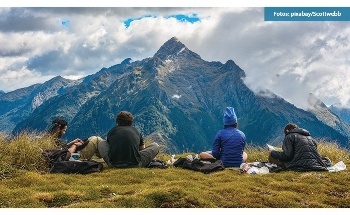Green Frequency
February 21, 2020
 There are more and more initiatives seeking to reconnect children, young people and adults with nature. Entries of a trend at the local and world level.
There are more and more initiatives seeking to reconnect children, young people and adults with nature. Entries of a trend at the local and world level.
Twenty-one million students. The figure represents 40 percent of all American school-age children. To each of them, the National Wildlife Federation (NWF) aims to bring them closer to nature so they can experience outdoor experiences with some frequency.
It seems impossible, but it is not: between 2013 and 2015, the same NGO had set out to do it with ten million children and not only fulfilled this goal, but it exceeded it by 38%: the number amounted to almost fourteen million .
The project is an excellent example of how, at a global and national level, initiatives are being implemented to connect the young with ecology. According to a survey conducted by the Argentine Social Debt Observatory, belonging to the Universidad Católica Argentina (UCA), 52.8% of children and adolescents living in cities play outdoors less than forty minutes a day. This fact is interesting compared to the results of a recent research and British campaign, called Free the children, getting dirty is good: the time spent in the open air the prisoners of some prisons of maximum security of the United States reaches The two hours.
For this reason, raising awareness about this issue became fundamental, especially in a current situation in which, according to the UCA study, 60% of children and adolescents exceeds one hundred twenty minutes a day in front of television screens, Cell phone, computer and tablet. Experts agree that moving away from the goodness that nature provides can have negative consequences for health. Some of the symptoms are obesity, stress, learning disorders, hyperactivity, chronic fatigue and depression, among others. “Nature’s deficit syndrome,” sums up activist Richard Louv, author of books like Back to Nature and The Last Child in the Woods, and says, “On the contrary, the proven benefits of well-being when you spend more time outdoor,
From the NWF, they argue that when children spend time in natural environments, when they turn their attention to animals and plants, and when they incorporate and apply knowledge that makes them feel fulfilled and talented, they develop a love for it all. This can happen while in the garden, creating inventories of flora and fauna, when they visit a park or when they play in patios specially designed for the occasion. Kevin Coyle, vice president of educational programs at NWF, explains: “The twenty-one million campaign focuses on promoting contact with nature in spaces where the smallest, already spend their time, such as schools, Early childhood centers, recreation agencies, parks, and extracurricular programs. “
Along with other NGOs, NWF promotes reforms in public policies and funding, and spearheads different types of actions, such as a camping campaign. “There’s no better way for the younger guys to deepen their relationship with the natural world than to spend a night outdoors under the stars,” says NWF president Collin O’Mara.
Along the same lines, while also targeting an adult audience, the National Outdoor Leadership School (NOLS) works, which offers programs and organizes expeditions to wild destinations around the planet, where participants incorporate different survival and leadership skills. How? They must find or set up shelters for sleep, design strategies to get their own food, orient themselves through maps, or prevent and treat wounds.
Read the full story here.
Topics: News

